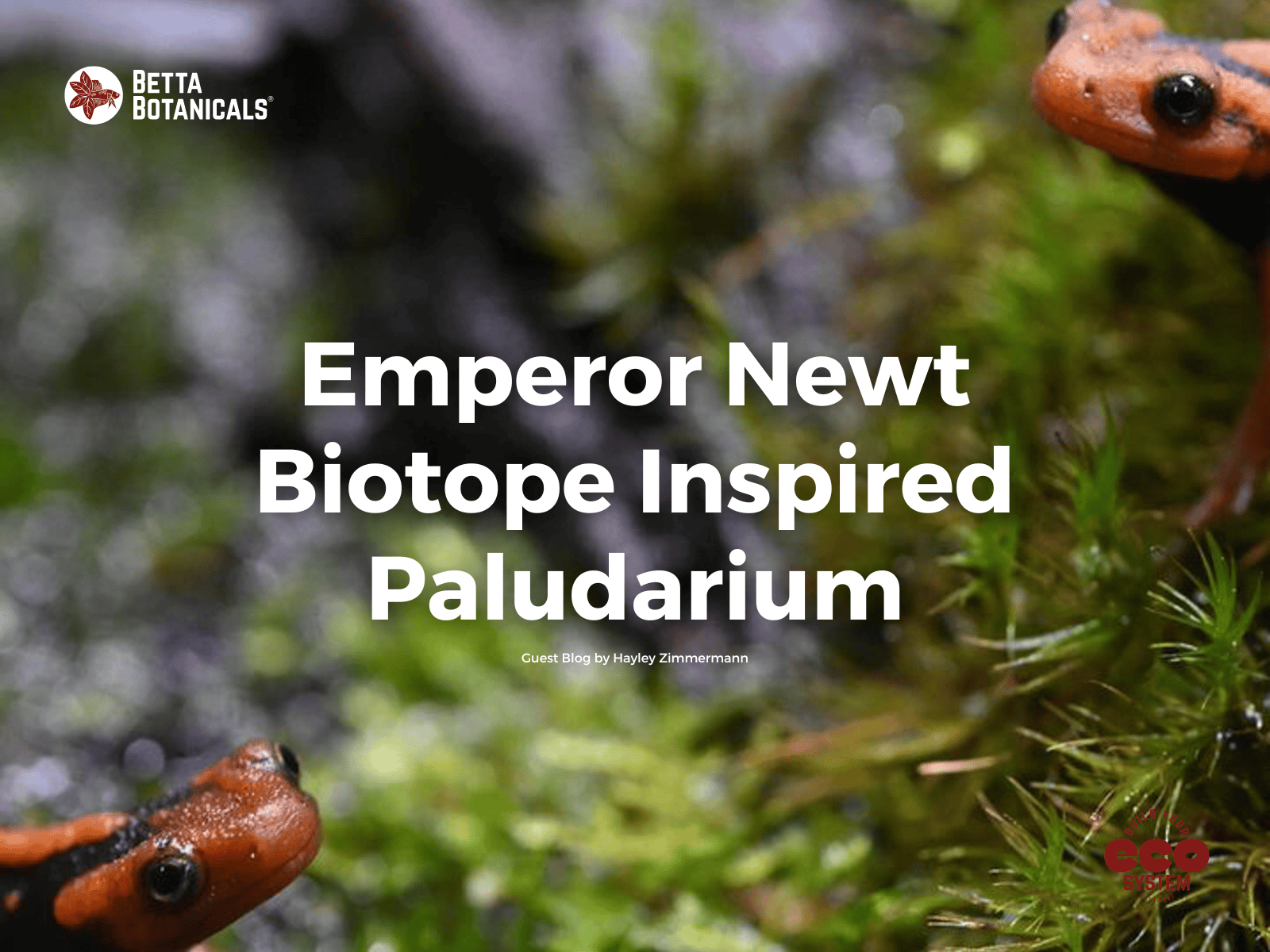A Botanical Method Aquarium How To: Keeping Sparkling Gourami
Author: Calvin Darling

What’s not to love about the Sparkling Gourami.
Meet The Genus Trichopsis
We all know that here at Betta Botanicals... bettas rule! Sometimes you may want something a bit different in your blackwater aquarium. This is where the lovely genus of Trichopsis comes into play, they are some stunning fish. There are currently three recognized species of Trichopsis listed largest to smallest: Trichopsis vittata (Croaking gourami), Trichopsis schalleri (Threestripe gourami), and Trichopsis pumila (Sparkling gourami), all of which make create inhabitats to a botanical aquarium full of tangled roots and tinted water. The Croaking gourami (T. vittata) is the largest of the genus massing 2.3”-2.8” in length, they are also the most aggressive of the three species and a pair should be confined to at least a 24” x 12” tank. Next up is the rarest available of the three species, the Threestripe gourami (T. shalleri). This gourami masses 1.6”-2” in length and while slightly smaller a small group should still be kept in tanks around the 20”-24” x 12” size to help balance any possible aggression. Finally, the gem of the Trichopsis is the Sparking gourami (T. pumila) massing 1.3”-1.6” this is the smallest of the three Trichopsis, but also the most colorful of them all. The small size also means that a smaller tank from 12”-18” can house groups of these mini gourami. The small size of them tend to get lost in bigger tanks and they are the most docile of the three species.

Plants can be an amazing addition to help break up sight lines for the gourami.
Cautionary Croaking In The Leaf Litter Bed
These fish make noises, in fact that is how they got the trade name of Croaking gourami to begin with. The croaking or clicking noise is produced from pectoral fin adaptations, like how crickets chirp. Both sexes have the ability to croak, and both males and females use the croaking during breeding displays. Males will also croak to establish dominance hierarchies, there is usually also a display of flaring and bluff strikes. The actual intensity of the croak shocked me when I first heard it happen. I could easily hear some croaking in the office tank when I was out in our living room or when they were in the bedroom, it startled me for sure. I would recommend not keeping this fish in the bedroom due to just how loud the croaking can be. All that aside, they are fascinating fish that do deserve a place in a botanical aquarium. Also being an Anabantid the gourami’s can breathe oxygen from above the water’s surface using their labyrinth organ just like Bettas. It is important that there is a 1/2'” of so layer of humid air available via a lid with vents. The lid will also prevent jumpers as these gourami can also be problematic floor surfers from time to time. Moving away from Trichopsis as a whole, the rest of the article will be solely focused on keeping and maintaining Sparkling gourami.

Every good botanical aquarium starts with the substrate.
Natural History Of Sparkling Gourami
Sparkling gourami are found residing in the lower Mekong River basin that encompasses Laos, Cambodia, and Thailand as well as watersheds in Central and peninsular Thailand. There have also been feral populations of the larger Croaking gourami found in Southern Florida! Sparkling gourami are found in all slow-moving habitats including forested swamps, peat swamps, and roadside ditches. These habitats are likely filled with lots of leaves, twigs, seed pods detritus, and algae; the substrate is also composed of a variety of dirt, clay, and peat-like mulm. Water chemistry parameters typically follow 72F-82F, pH 5.0-7.5 (can take higher if tank-raised), hardness of 18-215ppm. Many of the habitats are also tannin-stained to some extent which really makes the Sparkling gourami pop out. All of this sounds like the perfect botanical aquarium if you ask me.

A simple collection of wood, tannins, and botanicals can replicate habitats around the world.
Basics of Aquarium Setup For Sparkling Gourami
First of all, these fish come from slow moving waters, so filtration flow needs to be reduced to prevent the gourami from getting blown around. Being a fish maxing around 2” the aquarium does not need to be that large. Aquariums ranging in size from 5.5 gallons and up are perfect, I have noticed that these fish tend to do a lot of hovering and are not super active. They still do need a minimum of 5.5 gallons due to territory establishment of males. I do also believe that due to their smaller size, a larger tank will cause the fish to disappear, and smaller tanks seem to be better for them. Do not disregard the need for cleaning their blackwater ecosystem just because they are small in size. They still require normal water exchanges and thrive when provided new water conditioned with botanicals. Lighting should be dimmer due to the tannin-stained waters and forested areas these fish can come from naturally filter the light. Add in some driftwood to help break up sight lines and if you can try and add in some floaters too, Sparkling gourami seem to feel more secure with more cover. You can also add in some other aquatic plants if you want, like Java fern, Java moss, and Cryptocoryne are perfect plants that add to the ecosystem and help with territory establishment.

While a relatively peaceful gourami, I caution housing them with dwarf shrimps.
Sparkling Gourami Tankmate Tango
I think that keeping these fish as a species-specific tank brings out the best of these little gems. Natural behaviors are increased in a species only tank and it can also lead to a higher chance of spawning. The back-and-forth action of males establish territories is a fun sight to see, sometimes they can be a bit too snippy with certain tank makes. I know from experience that Sparkling gourami are not safe with any of the dwarf shrimp, the picture above was taken moments before that gourami hallowed out that Cherry shrimp. Larger shrimp like Amano and Bamboo shrimp should be fine, snails seem too also to be safe. Fish is a bit more of a challenge, loaches and some catfishes are great tankmates as well as smaller tetras and rasboras. Sometimes individual gourami does not tolerate other tankmates much like Bettas, so always keep an eye on your gourami when adding in new fish. Also on that note, if you want a group of gourami, you should add them all at one time to help establish the hierarchy from the beginning.

A mix of driftwood, roots, and leaves create the perfect base for a Sparkling gourami tank.
My Ideal Sparkling Gourami Setup
I would build the aquarium just like their natural habitat from the ground up. A substrate consisting of a fine golden sand is the perfect start, and that could be the only ingredient. I like to mix things up by adding in clays, crushed up leaves, barks, and coco coir/tree fern fiber to make the substrate as natural as possible. I would recommend seeding the tank 2-3 weeks ahead of time with microfauna like copepods, amphipods, and blackworms. All of these create an internal food web that can provide supplemental feeding for the gourami. My go-to hardscape would have to be Melastoma roots and Borneo Rasamala Roots. Botanical wise I would use some Shingles Live Oak Leaf Litter and Willow Oak Leaf Litter, Cariniana pods to provide caves for the gourami to claim, and my favorite swamp botanical is the Climbing Swamp Ferns. To learn how to prepare aquarium botanicals I would reference this page on Ben's website. All of these will create an amazing swamp looking tank perfect for your Sparkling gourami. To top off the selection would be Betta Tea Maroon to give that peat-stained look to your personal little swamp ecosystem. Aquarium wise would depend on how many you want, generally I keep 6 in a 20” x 10” aquarium. I hope all of this was helpful and I hope this inspires some people to add these hidden gems into their house.
About the Author: Meet Calvin Darling, a Botanical Aquarium Enthusiast
About Me: Hello blog readers, my name is Calvin Darling, and I am a member of the #TanninBae Ambassador program with Betta Botanicals. I have been keeping aquariums since I was 4 years old but have been keeping botanical method aquariums for the past three years. I specialize in biotope-inspired aquariums with an emphasis on inconspicuously colored fish and uncommonly kept livestock as well as root tangle scapes. My go-to botanicals must be Live oak, Shingle oak, Mokha pods, Parviflora pods, and Melastoma roots.









Inspire your friends:
Wild Betta Fish Diet: A Comprehensive Guide
Little Bugs In My Fish Tank: Microfauna of The Botanical Method Aquarium